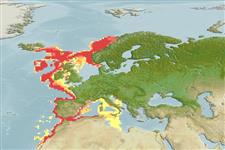Environment: milieu / climate zone / depth range / distribution range
Écologie
marin; non migrateur; profondeur 100 - 1000 m (Ref. 35388). Temperate; 69°N - 24°N, 18°W - 17°E
Northeast Atlantic: found in the western Mediterranean and in the Atlantic around the Strait of Gibraltar and to the south along the Moroccan coast.
Taille / Poids / Âge
Maturity: Lm ? range ? - ? cm
Max length : 16.1 cm TL mâle / non sexé; (Ref. 128593); common length : 10.0 cm TL mâle / non sexé; (Ref. 1371); poids max. publié: 48.98 g (Ref. 128593); âge max. reporté: 3.00 années (Ref. 1371)
Épines dorsales (Total) : 0; Épines anales: 0. Eyes large; mouth oblique; chin barbel absent. Color varies from pink to light brown dorsally, silvery on sides and ventrally (Ref. 1371). Scales large, silvery and easily detached. Lateral line ends in 7 open mucus grooves on the upper side of the head (Ref. 35388).
Occurs in large schools over mud, muddy sand, gravel and rock bottoms. Feeds on small crustaceans and maybe worms. Preyed upon by other valuable fish (Ref. 1371). Spawns in the winter in the western Mediterranean and in the spring farther north (Ref. 35388).
Life cycle and mating behavior
Maturité | Reproduction | Frai | Œufs | Fécondité | Larves
The major spawning grounds are located in the western part of the Mediterranean, on both sides of the Straits of Gibraltar, in deep water.
Cohen, D.M., T. Inada, T. Iwamoto and N. Scialabba, 1990. FAO species catalogue. Vol. 10. Gadiform fishes of the world (Order Gadiformes). An annotated and illustrated catalogue of cods, hakes, grenadiers and other gadiform fishes known to date. FAO Fish. Synop. 125(10). Rome: FAO. 442 p. (Ref. 1371)
Statut dans la liste rouge de l'IUCN (Ref. 130435: Version 2024-1)
Menace pour l'homme
Harmless
Utilisations par l'homme
Pêcheries: intérêt commercial mineur; appât: usually
Outils
Articles particuliers
Télécharger en XML
Sources Internet
Estimates based on models
Preferred temperature (Ref.
123201): 3.4 - 13.9, mean 7.9 °C (based on 254 cells).
Phylogenetic diversity index (Ref.
82804): PD
50 = 0.7500 [Uniqueness, from 0.5 = low to 2.0 = high].
Bayesian length-weight: a=0.00661 (0.00553 - 0.00789), b=3.09 (3.04 - 3.14), in cm total length, based on LWR estimates for this species (Ref.
93245).
Niveau trophique (Ref.
69278): 3.6 ±0.3 se; based on diet studies.
Generation time: 5.8 ( na - na) years. Estimated as median ln(3)/K based on 2
growth studies.
Résilience (Ref.
120179): Milieu, temps minimum de doublement de population : 1,4 à 4,4 années (K=0.19-0.50; tmax=3.0).
Fishing Vulnerability (Ref.
59153): Low to moderate vulnerability (25 of 100).
Nutrients (Ref.
124155): Calcium = 61.8 [31.4, 132.3] mg/100g; Iron = 0.524 [0.258, 1.013] mg/100g; Protein = 17.8 [16.3, 19.3] %; Omega3 = 0.96 [0.45, 2.06] g/100g; Selenium = 12.2 [5.0, 31.6] μg/100g; VitaminA = 24.4 [5.5, 106.1] μg/100g; Zinc = 0.755 [0.473, 1.180] mg/100g (wet weight);
